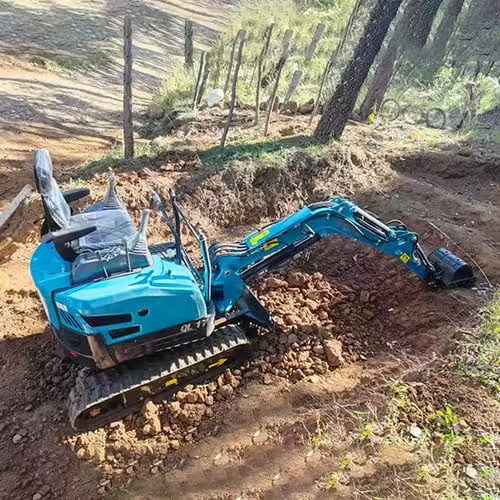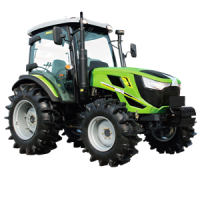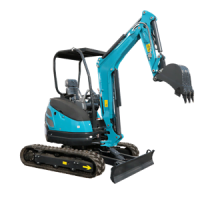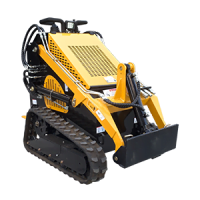مقدمة ل حفارة ضوابط
عندما يتعلق الأمر بتشغيل الحفار، فالأمر أكثر من مجرد حفر الأوساخ. السر يكمن في إتقان فن التحكم في الحفارات. توفر هذه الآلات القوية مجموعة واسعة من الوظائف التي يمكن أن تجعل عملك فعالاً ودقيقًا، ولكن فقط إذا كنت تعرف كيفية التعامل معها بمهارة.
سواءً كنتَ مُشغّلاً مُحنّكاً تتطلع إلى تحسين تقنياتك أو مبتدئاً مُتحمساً لتعلّم أساسيات التشغيل، فإنّ هذه التدوينة هنا لإرشادك إلى كل ما تحتاج لمعرفته حول أدوات التحكم في الحفارات. من فهم أنواع أدوات التحكم المختلفة ووظائفها، إلى أفضل الممارسات لتشغيلها بسلاسة - ستجد لدينا ما يُلبي احتياجاتك.
لذا، استعدوا لنغوص في عالم أدوات التحكم بالحفارات! بفضل نصائح خبرائنا ورؤانا الثاقبة، ستتمكنون قريبًا من تشغيل هذه الآلات الجبارة باحترافية، مما يزيد إنتاجيتكم إلى أقصى حد مع الحفاظ على أقصى درجات الدقة. هيا بنا!
أهمية الإتقان حفارة ضوابط

يُعدّ إتقان التحكم في الحفارات أمرًا بالغ الأهمية لأي شخص يُشغّل الآلات الثقيلة في مشاريع البناء أو الحفر. تُمكّن هذه الضوابط المُشغّلين من مناورة الحفارات بدقة وكفاءة، مما يضمن إنجاز المهام بأمان ودقة.
من أهم أسباب أهمية إتقان التحكم في الحفارات هو تعزيز الإنتاجية في موقع العمل. فعندما يتمكن المشغل من التحكم بسلاسة في حركة الآلة، يتمكن من إنجاز المهام بسرعة وفعالية أكبر. وهذا لا يوفر الوقت فحسب، بل يزيد أيضًا من كفاءة المشروع بشكل عام.
من الجوانب المهمة الأخرى لإتقان هذه الضوابط السلامة. فالحفارات آلات قوية تتطلب تعاملاً دقيقاً لتجنب الحوادث أو تلف الممتلكات. ومن خلال فهم وتطبيق تقنيات التحكم المناسبة، يمكن للمشغلين تقليل المخاطر والحفاظ على بيئة عمل آمنة لأنفسهم ولمن حولهم.
بالإضافة إلى ذلك، يُمكّن إتقان التحكم في الحفارات المُشغّلين من تحقيق دقة أكبر في عملهم. سواءً كان العمل حفر خنادق أو إزالة أنقاض، فإنّ التحكّم الكامل في حركة الآلة يُمكّن من وضع المواد بدقة أو إزالة العناصر غير المرغوب فيها.
علاوة على ذلك، من خلال إتقان استخدام أنواع مختلفة من أدوات التحكم في الحفارات، مثل أنظمة التحكم بالدواسة أو عصا التحكم، يمكن للمشغلين التكيف بسهولة مع مختلف طرازات المعدات. تضمن هذه المرونة كفاءتهم العالية بغض النظر عن النوع أو العلامة التجارية التي يستخدمونها في مواقع العمل المختلفة.
في الختام، إن إتقان التحكم في الحفارات يتجاوز مجرد معرفة كيفية تشغيل الآلة، بل يُمكّن المُشغّلين من تحسين الإنتاجية، وتعزيز إجراءات السلامة، وتحسين الدقة، والقدرة على التكيف مع مختلف طرازات المعدات. وهو أمرٌ أساسيٌّ لأيّ محترف يسعى إلى النجاح في مجال البناء أو الحفر!
أنواع أدوات التحكم في الحفارات ووظائفها
الحفارات آلات متعددة الاستخدامات، مزودة بأنواع مختلفة من أدوات التحكم لتناسب مختلف التطبيقات. يُعد فهم أنواع أدوات التحكم المختلفة في الحفارات ووظائفها أمرًا بالغ الأهمية للمشغلين لتحقيق أقصى قدر من الكفاءة والدقة في عملهم.
1. عناصر التحكم القياسية للحفارة:
أكثر أنواع أدوات التحكم شيوعًا في الحفارات هو التكوين القياسي، المعروف أيضًا باسم "SAE" أو "cat". في هذا التكوين، تتحكم عصا التحكم اليسرى في حركات ذراع الرافعة والجرافة، بينما تتحكم عصا التحكم اليمنى في حركات التأرجح والذراع. يُستخدم هذا التكوين على نطاق واسع في أمريكا الشمالية.
2. ضوابط حفارة ISO:
تحظى أنظمة التحكم في الحفارات وفقًا لمعايير المنظمة الدولية للمعايير (ISO) بشعبية واسعة في أوروبا ومناطق أخرى من العالم. في هذا التصميم، تُدير عصا التحكم اليسرى حركات الذراع والرافعة، بينما تُدير عصا التحكم اليمنى حركة التأرجح وحركة الجرافة. يوفر هذا التصميم تصميمًا أكثر راحةً مقارنةً بنظام تحكم SAE.
3. أدوات التحكم في الحفارات ذات طراز الحفارات الخلفية:
تشبه أدوات التحكم في الجرافات الخلفية آلية تشغيل آلة الجرافة الخلفية، مما يُسهّل على المشغلين ذوي الخبرة في تشغيل الجرافات الخلفية أو الجرافات الانزلاقية. يُحرّك الذراع الأيسر ذراع الرافعة والدلو لأعلى ولأسفل في آنٍ واحد، بينما يُتيح لفّه إمكانية تدوير المعصم.
4. حفارات التوجيه ذات عصا التحكم:
تتميز حفارات التوجيه بعصا تحكم مزودة بعصاتي تحكم بدلاً من دواسات القدم التقليدية. تتحكم حركات يد المشغل على هاتين العصاتين بجميع جوانب الحفر، من القيادة للأمام/الخلف إلى المناورة في مواقع العمل، مما يزيد من دقة التشغيل.
يتمتع كل نوع من أنواع التحكم في الحفارات بمزاياه الخاصة اعتمادًا على تفضيلات المشغل، ومعرفته، ومتطلبات التطبيق، والممارسات الإقليمية.
بفضل إلمامهم بجميع أنواع أدوات التحكم في الحفارات المتوفرة اليوم، يمكن للمشغلين التكيف بسرعة عند العمل مع آلات مختلفة أو مواجهة ظروف مختلفة في موقع العمل.
أفضل الممارسات للتشغيل أدوات التحكم في الحفارات
عند تشغيل حفارة، يُعدّ إتقان التحكم أمرًا بالغ الأهمية لتحقيق أقصى قدر من الكفاءة والدقة. سواء كنتَ مُشغّلًا مُحنّكًا أو مبتدئًا في قطاع الإنشاءات، فإنّ اتباع أفضل الممارسات يُمكن أن يُساعدك على تحقيق أقصى استفادة من آلتك.
تعرّف على أنواع أدوات التحكم المختلفة في الحفارات ووظائفها. النوعان الرئيسيان هما أدوات التحكم بعصا التحكم وذراع التحكم. توفر أدوات التحكم بعصا التحكم مرونة أكبر ويفضلها العديد من المشغلين، بينما توفر أدوات التحكم بذراع التحكم نهجًا أكثر تقليدية.
بعد اختيار نوع التحكم المُفضّل لديك، من المهم الحفاظ على وضعية اليد الصحيحة دائمًا. هذا يضمن لك تحكمًا كاملًا بكل حركة وتشغيل الحفارة بسلاسة.
بالإضافة إلى وضعية اليد الصحيحة، يُعد الحفاظ على وضعية جيدة أمرًا بالغ الأهمية عند تشغيل الحفارة. فالجلوس بشكل مستقيم مع تثبيت القدمين بثبات على الأرض لن يُقلل التعب فحسب، بل سيُحسّن أيضًا تحكمك العام بالآلة.
من الممارسات الأساسية الأخرى البدء ببطء وزيادة السرعة تدريجيًا مع اكتساب الثقة في التعامل مع الحفارة. قد يؤدي التسرع في التحركات السريعة دون خبرة كافية إلى وقوع حوادث أو أضرار بالهياكل المحيطة.
علاوة على ذلك، انتبه دائمًا لمحيطك أثناء تشغيل الحفارة. انتبه جيدًا لخطوط الكهرباء العلوية، والمرافق تحت الأرض، وأي مخاطر محتملة قد تؤثر على منطقة عملك.
يجب أن تكون الصيانة والفحوصات الدورية جزءًا من روتينك عند تشغيل الحفارات. فحص مستويات السوائل، وفحص المسارات أو الإطارات بحثًا عن أي تآكل أو تلف، والتأكد من عمل جميع ميزات السلامة بشكل صحيح، كلها عوامل تُسهم بشكل كبير في كفاءة التشغيل.
وأخيرًا، لا تنسَ أهمية التعلم المستمر! فالاطلاع على أحدث التقنيات أو حضور الدورات التدريبية يُحسّن مهاراتك كمشغل.
من خلال تطبيق أفضل الممارسات هذه في عملياتك اليومية باستخدام الحفارة - من اختيار نوع التحكم المناسب إلى الحفاظ على الوضع المناسب - ستكون في طريقك نحو تحقيق قدر أكبر من الكفاءة والدقة في كل مشروع!
الأخطاء الشائعة التي يجب تجنبها عند الاستخدام حفارة ضوابط
قد يكون تشغيل الحفارة مهمةً صعبة، خاصةً للمبتدئين. فهو يتطلب دقةً وتحكمًا دقيقًا لمناورة الآلة بكفاءة. ومع ذلك، حتى المُشغّلين ذوي الخبرة قد يرتكبون أخطاءً قد تؤدي إلى حوادث أو عملٍ غير فعال. إليك بعض الأخطاء الشائعة التي يجب تجنبها عند استخدام أدوات التحكم في الحفارات:
١. الإفراط في استخدام أدوات التحكم: قد يؤدي الضغط الشديد على أذرع التحكم إلى حركات متقطعة وضعف الدقة. من المهم الحفاظ على لمسة لطيفة والضغط الكافي للحصول على الاستجابة المطلوبة من الجهاز.
٢. إهمال الصيانة: قد يؤدي عدم فحص وصيانة أدوات التحكم في الحفارة بانتظام إلى حدوث أعطال أو أعطال أثناء التشغيل. تأكد دائمًا من عدم وجود أي توصيلات مفكوكة أو أسلاك تالفة أو مكونات مهترئة قبل بدء العمل.
٣. تجاهل إرشادات السلامة: يجب أن تكون السلامة دائمًا على رأس أولوياتنا عند تشغيل الآلات الثقيلة كالحفارات. إهمال إجراءات السلامة المناسبة، مثل ارتداء معدات الوقاية، أو تأمين موقع العمل، أو الالتزام بحدود سعة الحمولة، قد يُعرّضك أنت والآخرين للخطر.
٤. ضعف التواصل مع موظفي الموقع: يُعدّ التواصل الواضح بين المُشغّل وموظفي الموقع أمرًا بالغ الأهمية لضمان سير العمل بسلاسة في مواقع البناء. قد يؤدي عدم التواصل الفعال بشأن توجيهات الحركة أو المخاطر المحتملة إلى وقوع حوادث أو تأخيرات.
٥. عدم الإلمام بأنواع مختلفة من أدوات التحكم: تأتي الحفارات بتكوينات تحكم متنوعة، مثل الأنظمة الهيدروليكية التي يتم التحكم بها بواسطة عصا التحكم أو الأنظمة التي تعمل بدواسة القدم. إذا لم تكن على دراية بهذه الإعدادات المختلفة، فمن الضروري تلقي تدريب مناسب قبل الشروع في أي مهام.
من خلال تجنب هذه الأخطاء الشائعة عند استخدام أدوات التحكم في الحفارات، فلن تعمل على تحسين كفاءتك فحسب، بل ستعزز أيضًا السلامة العامة في الموقع.
تقنيات متقدمة لتحقيق أقصى قدر من الكفاءة والدقة

عندما يتعلق الأمر بتشغيل الحفارات، فإن إتقان أدوات التحكم الأساسية هو مجرد البداية. وللتفوق الحقيقي في هذا المجال، يجب على المشغلين التعرّف على التقنيات المتقدمة التي تُحسّن الكفاءة والدقة. صُممت هذه التقنيات لمساعدة المشغلين على تحقيق أقصى استفادة من معداتهم مع تقليل الأخطاء وزيادة الإنتاجية إلى أقصى حد.
تُعرف إحدى التقنيات المهمة باسم "التدرج"، وهي تعتمد على التحكم الدقيق بأدوات التحكم الهيدروليكية لتحقيق حركات سلسة ودقيقة. بالضغط الخفيف على عصي التحكم أو الدواسات، يمكن للمشغلين إجراء تعديلات دقيقة لتجنب الحركات المفاجئة التي قد تؤدي إلى عدم الدقة أو التلف.
من التقنيات الأخرى التي يستخدمها مشغلو الحفارات ذوو الخبرة تقنية "التمركز". تتضمن هذه التقنية تحديد موضع الآلة بدقة بالنسبة لمنطقة عملها لتحقيق أقصى مدى وثبات. باختيار الزاوية والمسافة المناسبين من المنطقة المستهدفة، يمكن للمشغلين تحقيق أقصى قدر من الكفاءة بتقليل عمليات إعادة التموضع أو التعديلات غير الضرورية.
علاوة على ذلك، فإن استخدام تقنيات التحكم السليمة في الجرافة يُحسّن الكفاءة بشكل ملحوظ أثناء أعمال الحفر. ينبغي على المشغلين التدرب على الحفاظ على حركة حفر ثابتة مع تجنب التأرجح المفرط أو التوقف المفاجئ. هذا يسمح بعمليات حفر أكثر سلاسة دون إهدار الوقت أو الجهد.
بالإضافة إلى ذلك، يُحسّن استخدام تقنيات حفر الخنادق الفعّالة دقة العمل في مشاريع مثل تركيب خطوط الأنابيب أو الأساسات. ينبغي على المُشغّلين اتباع نهج مُنتظم، بدءًا من أحد طرفي الخندق، ثمّ العمل تدريجيًا نحو الطرف الآخر. هذا يضمن تساوي العمق في جميع أنحاء الخندق مع تقليل أيّ انحرافات أو تناقضات.
يمكن أن يرتقي استخدام التطورات التكنولوجية، مثل أنظمة تحديد المواقع العالمية (GPS) وأدوات التوجيه بالليزر، بدقة الحفر إلى مستويات جديدة. توفر هذه الأدوات معلومات آنية حول تتبع المواقع، وتضمن دقة القطع وفقًا لمواصفات المشروع.
ومن خلال تطبيق هذه التقنيات المتقدمة في عملياتهم اليومية، يمكن لمشغلي الحفارات تحسين مستويات الكفاءة والدقة بشكل كبير، مما يؤدي إلى تحسين الأداء بشكل عام.
استنتاج
إتقان حفارة يُعدّ استخدام أدوات التحكم أمرًا بالغ الأهمية لتحقيق الكفاءة والدقة الأمثل في مشاريع البناء والحفر. سواء كنتَ مُشغّلًا خبيرًا أو مبتدئًا، فإن فهم أنواع أدوات التحكم المختلفة في الحفارات ووظائفها أمرٌ أساسي.
من خلال التعرّف على أنظمة التحكم المتنوعة المتاحة، مثل أذرع التحكم والدواسات وواجهات شاشات اللمس، يمكنك اختيار النظام الذي يناسب تفضيلاتك وأسلوب عملك. من أفضل الممارسات لتشغيل أدوات التحكم في الحفارات الحفاظ على وضعية جلوس مريحة، واستخدام حركات سلسة لتقليل الحركات المفاجئة، والانتباه الدائم لمحيطك.
تجنب الأخطاء الشائعة، مثل الإفراط في التعويض أو الاعتماد على طريقة تحكم واحدة فقط، سيساعد في منع الحوادث أو تلف المعدات. وبتطبيق تقنيات متقدمة، مثل أنظمة التحكم الهيدروليكية المساعدة التي يتم التحكم بها بالإبهام أو استخدام تقنية تحديد المواقع العالمي (GPS) للحفر الدقيق، يمكنك الارتقاء بإنتاجيتك إلى مستويات جديدة.
تذكر أن إتقان التحكم في الحفارات يتطلب وقتًا وممارسة. التعلم المستمر من المشغلين ذوي الخبرة، ومواكبة التطورات في الصناعة، والسعي للحصول على تدريب إضافي، كل ذلك يُحسّن مهاراتك.
سواءً كنت تحفر خنادق أو تعمل في مهام هدم معقدة، اجعل السلامة دائمًا في مقدمة أولوياتك مع السعي لتحقيق أقصى قدر من الكفاءة والدقة من خلال إتقان التحكم في الحفارات. بالتفاني والتشغيل الماهر لآليات هذه الآلات القوية والمعقدة، ستكون مجهزًا تجهيزًا كاملاً للتعامل مع أي مهمة تواجهك!





-1.png)